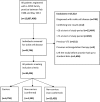Venous thromboembolism in adults screened for sickle cell trait: a population-based cohort study with nested case-control analysis
- PMID: 28360235
- PMCID: PMC5372149
- DOI: 10.1136/bmjopen-2016-012665
Venous thromboembolism in adults screened for sickle cell trait: a population-based cohort study with nested case-control analysis
Abstract
Objective: To determine whether sickle cell carriers ('sickle cell trait') have an increased risk of venous thromboembolism (VTE).
Design: Cohort study with nested case-control analysis.
Setting: General population with data from 609 UK general practices in the Clinical Practice Research Datalink (CPRD).
Participants: All individuals registered with a CPRD general practice between 1998 and 2013, with a medical record of screening for sickle cell between 18 and 75 years of age.
Main outcomes measures: Incidence of VTE per 10 000 person-years (PY) among sickle cell carriers and non-carriers; and adjusted OR for VTE among sickle cell carriers compared with non-carriers.
Results: We included 30 424 individuals screened for sickle cell, with a follow-up time of 179 503 PY, identifying 55 VTEs in 6758 sickle cell carriers and 125 VTEs in 23 666 non-carriers. VTE incidence among sickle cell carriers (14.9/10 000 PY; 95% CI 11.4 to 19.4) was significantly higher than non-carriers (8.8/10 000 PY; 95% CI 7.4 to 10.4). Restricting analysis to confirmed non-carriers was non-significant, but performed on a small sample. In the case-control analysis (180 cases matched to 1775 controls by age and gender), sickle cell carriers remained at increased risk of VTE after adjusting for body mass index, pregnancy, smoking status and ethnicity (OR 1.78, 95% CI 1.18 to 2.69, p=0.006), with the greatest risk for pulmonary embolism (PE) (OR 2.27, 95% CI 1.17 to 4.39, p=0.011).
Conclusions: Although absolute numbers are small, in a general population screened for sickle cell, carriers have a higher incidence and risk of VTE, particularly PE, than non-carriers. Clinicians should be aware of this elevated risk in the clinical care of sickle cell carriers, or when discussing carrier screening, and explicitly attend to modifiable risk factors for VTE in these individuals. More complete primary care coding of carrier status could improve analysis.
Keywords: Venous thromboembolism; cohort study; sickle cell trait;.
Published by the BMJ Publishing Group Limited. For permission to use (where not already granted under a licence) please go to http://www.bmj.com/company/products-services/rights-and-licensing/.
Conflict of interest statement
Figures
Similar articles
-
Venous thromboembolism incidence in the Cooperative Study of Sickle Cell Disease.J Thromb Haemost. 2014 Dec;12(12):2010-6. doi: 10.1111/jth.12744. Epub 2014 Oct 18. J Thromb Haemost. 2014. PMID: 25280124 Free PMC article.
-
An investigation of sickle cell trait, body mass index, and fitness in relation to venous thromboembolism among African American adults.J Thromb Haemost. 2021 Sep;19(9):2216-2224. doi: 10.1111/jth.15422. Epub 2021 Jul 8. J Thromb Haemost. 2021. PMID: 34105875
-
Epidemiology of first and recurrent venous thromboembolism: a population-based cohort study in patients without active cancer.Thromb Haemost. 2014 Aug;112(2):255-63. doi: 10.1160/TH13-09-0793. Epub 2014 Apr 3. Thromb Haemost. 2014. PMID: 24695909
-
Sickle-cell trait: novel clinical significance.Hematology Am Soc Hematol Educ Program. 2010;2010:418-22. doi: 10.1182/asheducation-2010.1.418. Hematology Am Soc Hematol Educ Program. 2010. PMID: 21239829 Free PMC article. Review.
-
The current state of sickle cell trait: implications for reproductive and genetic counseling.Hematology Am Soc Hematol Educ Program. 2018 Nov 30;2018(1):474-481. doi: 10.1182/asheducation-2018.1.474. Hematology Am Soc Hematol Educ Program. 2018. PMID: 30504348 Free PMC article. Review.
Cited by
-
Incidental Findings of Sickle Cell Trait From an Everyday Diabetes Test: Should General Health Care Providers and Testing Centers Report, Retest, or Refer?Clin Diabetes. 2020 Jan;38(1):101-107. doi: 10.2337/cd19-0004. Clin Diabetes. 2020. PMID: 31975759 Free PMC article. Review. No abstract available.
-
Multiple thromboembolic events associated with bilateral superior vena cava and anomalous drainage into the left atrium.BMJ Case Rep. 2021 Feb 1;14(2):e237401. doi: 10.1136/bcr-2020-237401. BMJ Case Rep. 2021. PMID: 33526519 Free PMC article.
-
Pregnancy in sickle cell trait: what we do and don't know.Br J Haematol. 2020 Aug;190(3):328-335. doi: 10.1111/bjh.16518. Epub 2020 Feb 17. Br J Haematol. 2020. PMID: 32064587 Free PMC article. Review.
-
Sickle cell disease, sickle trait and the risk for venous thromboembolism: a systematic review and meta-analysis.Thromb J. 2018 Oct 4;16:27. doi: 10.1186/s12959-018-0179-z. eCollection 2018. Thromb J. 2018. PMID: 30305805 Free PMC article.
-
Current Issues and Options for Hormonal Contraception in Adolescents and Young Adult Women With Sickle Cell Disease: An Update for Health Care Professionals.Mediterr J Hematol Infect Dis. 2020 May 1;12(1):e2020032. doi: 10.4084/MJHID.2020.032. eCollection 2020. Mediterr J Hematol Infect Dis. 2020. PMID: 32395221 Free PMC article. Review.
References
-
- Serjeant GR, Serjeant BE. Sickle cell disease. 3rd edn. Oxford: Oxford University Press, 2001.
-
- England. PH. NHS Sickle Cell and Thallasaemia programme Fact and Figures. Secondary NHS Sickle Cell and Thallasaemia programme Fact and Figures. http://sct.screening.nhs.uk/statistics
Publication types
MeSH terms
LinkOut - more resources
Full Text Sources
Other Literature Sources

